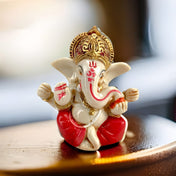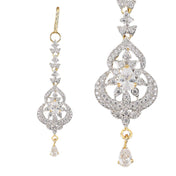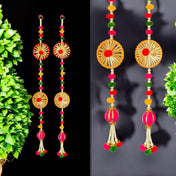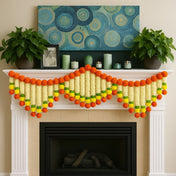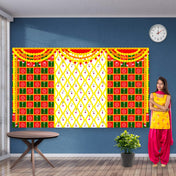Pooja backdrop decoration holds a cherished place in Indian rituals, serving as the sacred canvas that elevates the spiritual ambiance of any ceremony. The Indian pooja backdrop is more than mere adornment; it reflects deep cultural roots and devotion, making the pooja space inviting and auspicious. Traditional pooja decor often includes vibrant flowers, symbolic motifs, and intricate drapes, all thoughtfully arranged to honor divine presence.
In 2024, pooja backdrop decoration trends are witnessing a beautiful evolution that marries time-honored customs with contemporary aesthetics. This blend brings freshness to ritual spaces while preserving the sanctity and symbolism that define Indian spirituality. From eco-friendly materials to minimalist designs, these trends cater to diverse tastes without compromising on cultural richness.
Explore with us 10 stunning pooja backdrop decoration trends that promise to transform your sacred space. Each trend captures unique elements—from lush floral artistry and sustainable banana leaf accents to personalized DIY creations and creative lighting—that inspire both tradition lovers and modern enthusiasts alike. Prepare to discover ideas that enrich your pooja experience with elegance, vibrancy, and heartfelt devotion.
To create a stunning pooja backdrop for ceremonies, consider exploring our Pooja Backdrop Decoration Collection which offers traditional Indian backdrop decorations suitable for various occasions. You can also enhance your decor with our versatile Backdrop Hanging Collection, or add a unique touch with our Backdrop Cutouts Decor Collection. These decorative elements not only beautify the space but also serve as a reflection of the rich cultural heritage associated with Indian rituals.
The Cultural Significance of Pooja Backdrops
Pooja backdrops hold a deep cultural significance in Indian rituals, serving as more than just decorative elements. They create a spiritual ambiance that elevates the sanctity of pooja ceremonies, transforming ordinary spaces into sacred ones where devotees connect with the divine.
Symbolic Elements in Traditional Indian Pooja Backdrops
Traditional Indian pooja backdrops often feature symbolic elements such as:
- Marigold garlands representing purity and auspiciousness
- Mango leaves symbolizing prosperity and good fortune
- Sacred geometric patterns (like mandalas) invoking cosmic harmony
These carefully chosen components carry layers of meaning that resonate with spiritual beliefs, reinforcing the devotional atmosphere.
Functions of Pooja Backdrops
The backdrop’s decor functions as a visual anchor for worshippers, focusing their attention and devotion. It fosters a sense of reverence and peace, enhancing the overall experience during prayers. On a communal level, beautifully adorned pooja spaces encourage gathering and bonding among family and friends. The shared effort in creating and appreciating these backdrops strengthens cultural ties and collective faith.
The Essence of an Indian Pooja Backdrop
In essence, an Indian pooja backdrop is both a canvas for tradition and an enabler of heartfelt spiritual connection. Its presence enriches rituals by merging aesthetic beauty with profound symbolism.
1. Floral Backdrops – Freshness and Elegance
Floral backdrop decoration is a timeless favorite in Indian pooja settings, loved for its natural beauty and symbolic purity. Marigold decorations, with their bright orange and yellow colors, bring an aura of positivity and sanctity. Jasmine garlands, known for their delicate fragrance and pristine white flowers, add a layer of peace and devotion to the pooja space. Roses, available in various colors, offer a touch of elegance and richness.
Creating intricate floral patterns involves several traditional techniques:
- Layered Garland Making: String marigolds tightly to form thick, lush garlands that can be draped elegantly.
- Floral Torans: Combine jasmine buds with marigold clusters in alternating sequences to craft decorative hangings above the altar.
- Petal Rangoli Borders: Use loose flower petals arranged in symmetrical designs around the pooja area to enhance aesthetic appeal.
Benefits of floral backdrops go beyond visual charm:
- They symbolize freshness, new beginnings, and spiritual awakening.
- The gentle fragrance from fresh flowers purifies the environment, fostering calmness.
- The temporary nature of flowers reminds devotees of life’s fleeting beauty, deepening mindfulness during rituals.
Such backdrops create an auspicious atmosphere where spirituality breathes through every petal placed with devotion.
2. Using Banana Leaf Decorations for Eco-Friendly Aesthetics
Banana leaves are an important part of Indian traditions, especially during festivals like Diwali and important ceremonies such as Griha Pravesh poojas. These large, bright green leaves represent prosperity, purity, and new beginnings, making them a key natural element in pooja backdrop decoration trends.
Traditional Uses of Banana Leaves in Pooja Decor
In traditional setups, banana leaves are often used as the base or border around the altar space. This creates a refreshing background that goes well with floral arrangements. The smooth texture and rich green color of banana leaves complement vibrant marigolds and fragrant jasmine flowers. This combination not only looks appealing but also brings a sense of spirituality to the setting.
Benefits of using banana leaf decorations:
- Eco-friendly pooja decor option that reduces reliance on synthetic materials.
- Biodegradable and sustainable, aligning with growing environmental consciousness.
- Culturally significant, preserving ancestral customs while adapting to modern aesthetics.
- Adds natural freshness and organic vibrancy to the pooja environment.
Crafting pooja backdrops with banana leaves interwoven alongside fresh flowers creates a harmonious blend of tradition and nature. This trend reflects a deep respect for the earth’s resources while elevating the sacred ambiance through authentic, organic beauty. By embracing such natural elements, devotees foster a spiritual connection that honors both heritage and ecological responsibility.
3. DIY Floral Decor – Personalization and Creativity
Crafting your own floral arrangements and garlands for pooja backdrops has become a cherished trend, blending personal touch with devotional intent. This approach to DIY floral decoration allows worshippers to infuse their creativity into sacred spaces, making each setup unique and heartfelt. For those looking for more comprehensive guidance, here are some DIY tips and ideas that can help in creating a decorative pooja backdrop.
Tips for creating personalized and meaningful decorations:
- Select flowers with symbolic significance: Marigolds for auspiciousness, jasmine for purity, or lotus petals for spiritual awakening.
- Mix textures and colors: Combine soft blooms with vibrant blossoms to create visual harmony that pleases the eye and soul.
- Incorporate natural elements: Twigs, beads, or dried flowers can add depth while respecting traditional aesthetics.
- Design simple yet elegant garlands: Use cotton thread or silk ribbons as base materials for durability and beauty.
- Customize shapes: Circular patterns symbolize eternity; triangular motifs can represent divine trinity.
Handmade pooja decor nurtures an intimate connection between the devotee and the ritual space. The act of creating becomes a meditative process, enriching the spiritual ambiance while honoring age-old customs. Personalized backdrop ideas invite families to celebrate heritage actively rather than passively decorating.
Encouragement to explore one's artistic flair does not overshadow reverence—it complements tradition by adapting it thoughtfully to contemporary lifestyles. Such creative involvement results in backdrops that resonate deeply with individual beliefs and community values alike.
4. Varalakshmi Vratham Specific Decorations – Highlighting Festive Grandeur
Varalakshmi Vratham decor centers around creating an atmosphere that reflects the reverence and grandeur of this auspicious festival. One of the most distinctive features is the elaborate flower setups, which are meticulously arranged to honor Goddess Lakshmi, the symbol of prosperity and well-being. Flowers such as hibiscus, marigold, and lotus are often chosen for their vibrant colors and spiritual significance, crafted into intricate garlands and floral rangolis that adorn the pooja space.
Colorful drapes and fabrics play a pivotal role in enhancing the sacred ambiance. Rich hues like deep reds, bright oranges, and gold accents drape the backdrop, lending a regal touch that complements the floral arrangements. Textured silks or brocades with traditional motifs intensify the festive spirit and provide a warm, inviting setting for devotees.
Unique symbolic elements define this festival’s decoration style:
- Kalash (sacred pot) decorated with turmeric, kumkum, and betel leaves symbolizes abundance.
- Mango leaves torans hang gracefully at entrances or along the backdrop, representing freshness and vitality.
- Traditional brass lamps (diyas) illuminate the space, casting a divine glow essential to Varalakshmi Vratham ceremonies.
This festival-specific backdrop reflects devotion woven seamlessly with visual splendor, making every pooja moment deeply memorable.
5. Embracing Greenery Alongside Flowers for Vibrancy
Incorporating greenery in pooja backdrop decoration has become a cherished trend, blending fresh decorative elements with traditional floral designs. Green foliage brings life and vibrancy to the altar, balancing the bright hues of flowers with calming natural tones. This approach enhances the visual appeal while fostering a serene and peaceful atmosphere essential for spiritual rituals.
Common types of greenery used in Indian pooja backdrops include:
- Mango leaves: Symbolizing prosperity and good fortune, often strung into torans.
- Tulsi leaves: Revered for their sacredness and purifying qualities.
- Fern fronds: Adding texture and depth without overwhelming the floral arrangements.
- Areca palm leaves: Providing a broad, lush backdrop that complements bright flowers.
Greenery decor contributes not just aesthetically but also spiritually by creating a fresh, natural ambiance that invites calmness and focus during worship. The presence of foliage helps connect devotees with nature’s purity, enriching the devotional experience. This balance between flowers and greenery reflects evolving pooja backdrop decoration trends where elegance meets eco-consciousness, making the space both lively and tranquil.
6. Minimalistic Yet Elegant Designs for Modern Sensibilities
The rise of minimalistic pooja decor caters to those who seek simplicity intertwined with sacredness. This approach emphasizes the use of subtle color schemes such as soft pastels, muted golds, and gentle creams that evoke calmness and purity without overwhelming the senses. Minimal elements—like a single string of jasmine or a sleek brass diya—replace dense floral arrangements, allowing each component to breathe and shine.
Benefits of this style include:
- Enhanced spiritual focus: Reduced visual clutter helps devotees center their minds on prayer and meditation.
- Ease of maintenance: Fewer decorative pieces mean quicker setup and effortless cleanup.
- Timeless appeal: Such backdrops blend seamlessly with contemporary interiors without compromising tradition.
Examples of elegant backdrop ideas suited for modern homes are:
- A plain white fabric drape accented with a thin border of marigold garlands.
- A wooden panel adorned with a minimalist rangoli design painted in earthy tones.
- A clean, geometric frame wrapped lightly with festoons of tulsi leaves and small fairy lights.
This trend resonates strongly with urban households desiring pooja spaces that are both meaningful and visually serene, reflecting a refined balance between heritage and modern lifestyle.
7. Using Traditional Symbols to Enhance Spiritual Meaning
Pooja backdrops come alive when adorned with traditional symbols for pooja that deepen the spiritual atmosphere and connect participants to centuries-old rituals. Central to this decoration style are diyas—small oil lamps that radiate a warm, flickering glow symbolizing purity and the divine light dispelling darkness. Arranged artfully across the backdrop or placed near the altar, diyas not only illuminate but also sanctify the space, inviting auspiciousness.
Alongside diyas, metallic bells and sacred motifs like Om, Swastika, or Kalash enhance the backdrop’s spiritual depth. These symbols evoke blessings and protection, serving as visual mantras that focus devotees' minds during prayer.
Adding another layer of cultural richness are rangoli designs, which are traditionally drawn with colored powders or flower petals at the base of the altar or around the pooja area. Intricate rangolis elevate the decor by infusing vibrant colors and auspicious patterns that welcome positive energy and harmonize the setting. Their geometric shapes and floral patterns often mirror natural and cosmic cycles, making them meaningful complements to the spiritual ambiance.
Together, these elements form a cohesive tableau where light, symbol, and color interact. This blend strengthens devotional energy while honoring timeless traditions embedded in Indian rituals.
8. Layered Drapes – Adding Depth and Richness
Layered fabric drapes bring a captivating dimension to pooja backdrop decoration trends by creating rich backdrop textures that transform the altar into a visual sanctuary. The technique involves arranging multiple layers of fabrics, each with distinct colors, patterns, and textures, positioned one behind the other to produce a sense of depth that elevates the sacred space.
Techniques for Layered Drapes:
- Start with a base fabric in a solid, calming color such as deep maroon, royal blue, or earthy saffron to establish a foundational tone.
- Add middle layers featuring traditional Indian motifs like paisleys, floral prints, or zari work that reflect cultural heritage while enhancing visual interest.
- Top layers can include sheer fabrics like organza or netting with subtle embroidery or sequins to catch light softly and add ethereal charm.
- Use fabric lengths of varying widths and heights to avoid flatness; this staggered arrangement invites the eye to explore each layer.
- Secure drapes using decorative hooks or traditional tassels at strategic points to maintain graceful folds without sagging.
Choosing fabrics with natural fibers such as silk, cotton, or brocade not only honors tradition but also adds luxurious texture and richness. Colors inspired by auspicious themes—golden yellows, vibrant reds, and lush greens—contribute warmth and spiritual resonance.
Layered drapes serve as the perfect canvas for altar decoration techniques involving floral garlands, diyas, and sacred symbols. This multi-textured backdrop enhances the pooja's solemnity while providing an elegant frame that highlights deities and ritual elements beautifully.
9. Creative Lighting Effects to Elevate Evening Ceremonies
Lighting for pooja backdrop has transformed the ambiance of rituals, especially during evening or nighttime ceremonies. Soft, warm illumination can accentuate the sacred elements and elevate the spiritual experience.
- Fairy lights decor is a popular choice, offering a gentle glow that outlines floral arrangements, drapes, and traditional symbols without overpowering them. These tiny lights can be woven through garlands or draped along fabric layers to create a magical, twinkling effect.
- LED lamps provide versatility with adjustable brightness and color settings. They can highlight specific areas of the pooja space — from idols to rangoli patterns — ensuring every detail is visible and revered.
- Strategic placement of lighting enhances depth and texture in the backdrop, turning simple decorations into captivating focal points. Using dimmers or remote controls allows customization of light intensity according to the mood of the ritual.
- Combining fairy lights with traditional diyas blends modern convenience with age-old customs, preserving authenticity while embracing innovation.
Incorporating creative lighting not only beautifies the pooja setup but also fosters a calm, inviting atmosphere where devotees feel connected and immersed in their prayers. This trend shines brightly among 2024’s Pooja Backdrop Decoration Trends, proving how illumination enriches both aesthetics and devotion.










